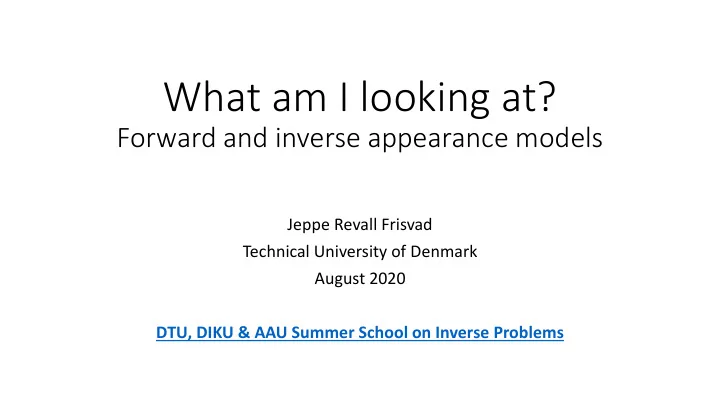

What am I looking at? Forward and inverse appearance models Jeppe Revall Frisvad Technical University of Denmark August 2020 DTU, DIKU & AAU Summer School on Inverse Problems
DTU Campus DTU Compute Technical University of Denmark was founded by H.C. Ørsted, the discoverer of electromagnetism, for developing and creating value through the technical and natural sciences to the benefit of society.
DTU Compute … … spans the entire spectrum from fundamental mathematics across mathematical modelling to computer science, which is the basis of the modern digital world. 11 research sections, 400 employees, 100 permanent academic staff members (faculty)
Section for Image Analysis and Computer Graphics statistical statistical IMAGE ANALYSIS COMPUTER VISION medical industrial 3D scan and print modeling GEOMETRIC DATA COMPUTER GRAPHICS processing rendering Jeppe Revall Frisvad jerf@dtu.dk https://people.compute.dtu.dk/jerf/
Research overview digital prototyping quality assessment synthetic data for learning rendering material digitizing cultural/natural heritage additive manufacturing appearance visualization scatter correction in imaging optical functional materials multiscale material modeling
Optical properties • Parameters that determine how light interacts with a material. • Quantum and wave theories: • Quantum scale: photon-electron interactions in atomic systems. • Nanoscopic scale: charge and current densities in atomic systems. • Microscopic scale: polarisation and magnetisation vectors. • Macroscopic scale: permittivity, permeability, conductivity. • Radiative transfer theory: • Microscopic scale: complex index of refraction. • Mesoscopic scale: surface BSDF, scattering cross section, phase function. • Macroscopic scale: scattering properties, BSSRDF, BRDF, BTDF.
particles microsurface Models at different scales • We divide the microscopic scale into • Nano/micro: models considering profilometry explicit microgeometry. • Micro/milli: models using particle size or microfacet normal distribution functions. normal distribution particle size distribution • We divide the macroscopic scale into • BSSRDF: models where the points of incidence and emergence are different. • BRDF/BTDF: local models for opaque/thin objects.
Formal models based on theory(t) • Mathematical models for optical properties. • Based on optics or radiative transfer theory. • Early examples: • Torrance-Sparrow BRDF [TS67,Bli77,CT81] • Chandrasekhar single-scattering BRDF/BTDF for layers [Bli82,HK93] • Scattering properties from densities [KV84,NIDN97,DEJ*99] • Kirchhoff approximation BRDF [Kaj85,HTSG91,Sta99] microsurface • BRDF/BTDF from ray tracing of microgeometry [CMS87,WAT92,GMN94] • Fibre scattering model (BCSDF) [KK89,MJC*03,ZW07] • Lorenz-Mie scattering properties [Cal96,JW97,FCJ07] • Diffusion dipole BSSRDF [JMLH01,DJ05] scattering by spherical particles dipole models
Forward simulation( ) • Computing optical properties at a more macroscopic scale. • Formulate a measurement equation and evaluate it by simulation. • Use microscale information to find a macroscopic function. • Examples: • Microfacet normal distribution BRDF/BTDF [TS67,Bli77,CT81,HTSG91,Sta99] • Explicitly defined microsurface BRDF/BTDF [Kaj85,CMS87,WAT92,GMN94] • Fibre geometry scattering properties [KK89] • particle concentrations BRDF [HM92,Cal96] • Spherical particle scattering properties [Cal96,JW97] • Explicitly defined microsurface microfacet normal distribution [Sta99] • BSSRDF BRDF [JMLH01]
−7 −5 2.5 2.5 skimmed 2 2 volume frequency volume frequency 1.5 1.5 mini 1 1 low fat whole 0.5 0.5 0 0 0 0.5 1 1.5 2 0 0.05 0.1 0.15 0.2 particle radius (microns) particle radius (microns)
pixel value pixel value Captured images used for estimating the reduced m) scattering coefficient: reduced scattering coefficient (1/m
white cardboard
Fine cloud Coarse cloud
Reference 4 days 9.5 days, peeled 9.5 days 27 days 0.0 g/L 0.1 g/L 0.2 g/L 0.5 g/L 1.0 g/L 2.0 g/L
4 days 9.5 days, peeled 9.5 days 27 days 0.0 g/L 0.1 g/L 0.2 g/L 0.5 g/L 1.0 g/L 2.0 g/L
Experimental(x) measurements • Instrumentation for acquiring optical properties. • Based on radiometry or one of the formal models. • Early examples: gonioreflectometry • (x2) Gonioreflectometric BRDF measurement [TS66,War92] • (x2/x3) Bidirectional Texture Function (BTF) [DVGNK99,DHT*00,TWL*05] • (x3) SVBRDF on 3D surface (structured light) [MWL*99,LKG*01,WMP*06] structured light scanning • (x2/x3) Diffuse reflectometry for scattering properties [JMLH01,GLL*04,TWL*05] • (x2) BRDF from curved sample geometry [MPBM03,NDM05] • (x1) Fibre scattering measurement [MJC*03,ZRL*09] diffuse reflectometry
Inverse technique( ) [Nielsen et al. SIGGRAPH Asia 2014 Posters] Example: model parameters BRDF • Compute microscale information by measuring at a macroscopic scale. L1 error • Examples: • BSSRDF diffuse reflectometry [JMLH01,GLL*04,TWL*05,DWd*08] • Composition parameters • BSSRDF structured light scan [PVBM*06,WMP*06,WZT*08,GHP*08] • Scattering properties photographing diluted liquid [NGD*06] • Fibre assembly microgeometry multiview photography [JMM09]
Example: spectral scattering properties diffuse reflectance lab setup in situ setup sample image (log transformed, false colours) Infer optical properties using an analytic subsurface scattering model reduced scattering [1/cm] absorption [1/cm] spectroscopy extract profile yogurt milk oblique incidence reflectometry wavelength [nm] wavelength [nm] [Abildgaard et al. Non-invasive assessment of dairy products using spatially resolved diffuse reflectance spectroscopy. Applied Spectroscopy 69 (9):1096-1105, 2015.]
Example: Particle size distributions optical properties Commercial milk products Oil-in-water emulsions our approach Mastersizer Nelder-Mead simplex search with a low-parameter size distribution function to fit measured scattering coefficients [5] with Lorenz-Mie theory [2]. Fit results compared with particle size distributions yogurt measured with a Malvern Mastersizer 3000. Effect of protein gel structure formation on apparent particle size milk distributions. This is useful for estimating viscosity or mouthfeel. Abildgaard et al. 2016. Noninvasive particle sizing using camera-based diffuse reflectance spectroscopy. Applied Optics 55 (14), pp. 3840-3846, May 2016.
More info on optical properties (forward and inverse models)
Recommend
More recommend